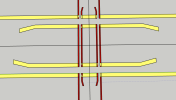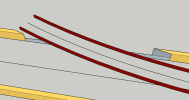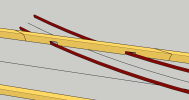BakerJohn
Baker, Modeler, future husband
Has anyone tried this sort of thing? I just did a quick SketchUp drawing for what I'm thinking. Ultimately, I want to the LHRR to have its 'full size' engines (running on 45mm track) and its own 1/4 scale engines (my HO stock running on 16.5mm track). My biggest problem I'm coming up with so far is that the flangeway for the 45mm through the HO rails would be way to big for HO trains to be able to safely cross the gap.
Below: my drawing with the flangeway gap (5mm gap) which results in a rail gap of about 25mm for the HO trains to (attemp to) cross.
Below: No gap for the 45mm track, just to show my drawing.

Any thoughts, suggestions are appreciated! Thanks!
Below: my drawing with the flangeway gap (5mm gap) which results in a rail gap of about 25mm for the HO trains to (attemp to) cross.

Below: No gap for the 45mm track, just to show my drawing.

Any thoughts, suggestions are appreciated! Thanks!







